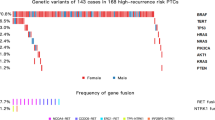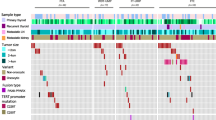Abstract
Introduction
In Colombia, thyroid cancer ranks among the highest incidences, yet our population lacks studies on its molecular profile. This study aims to characterize clinical, histopathologic and molecular data in a Colombian cohort with papillary thyroid carcinoma (PTC).
Methods
A retrospective review of clinical history, clinicopathologic characteristics, treatment and 5–10-year follow-up for all patients was done. DNA and RNA were extracted from formalin-fixed paraffin-embedded (FFPE) tissue using the Quick-DNA & RNA FFPE Min iPrep kit (Zymo Research). Next-generation sequencing (NGS) analysis was performed with SOPHiA Solid Tumor Solutions kit (SOPHiA GENETICS). Tumor mutation genomic analysis used SOPHiA DDM™ platform, with descriptive analysis reporting frequencies, means and associations via chi-square analysis.
Results
Among 231 sequenced patients, mean age at diagnosis was 46 (± 12.35) years, with higher frequency in women (81.82%). Two cases were reclassified as non-invasive follicular thyroid neoplasm (NIFT-P); an NRAS mutation was found in one of them. Predominant histologic subtype was classic PTC (57.64%) followed by tall cell (28.82%). Of the 229 sequenced carcinomas, mutations were identified in 186 cases, including BRAF, IDH1, RAS and PIK3CA. Notable copy number variations (CNVs) were PDGFRA, CDK4 and KIT, with RET being the most frequent gene fusion, including CCDC6-RET in two classic subtype cases.
Conclusion
This is the first study in Colombia (TIROSEC) to our knowledge that integrates molecular and histopathologic profiles enriching our local comprehension and knowledge of PTC. The identification of target mutations such as BRAF, RET and NTRK fusions holds the potential to guide targeted therapies for tumor recurrence and predict aggressive behavior.

Similar content being viewed by others
Data Availability
All data generated or analyzed during this study are included in this published article/as supplementary information files.
References
Fitzmaurice C, Akinyemiju TF, Al Lami FH, Alam T, Alizadeh-Navaei R, Global Burden of Disease Cancer Collaboration, et al. Global, regional, and national cancer incidence, mortality, years of life lost, years lived with disability, and disability-adjusted life-years for 29 cancer groups, 1990 to 2016: a systematic analysis for the global burden of disease study. JAMA Oncol. 2018;4:1553. https://doi.org/10.1001/jamaoncol.2018.2706.
Kitahara CM, Sosa JA. Understanding the ever-changing incidence of thyroid cancer. Nat Rev Endocrinol. 2020;16:617–8. https://doi.org/10.1038/s41574-020-00414-9.
Lam AK. Papillary thyroid carcinoma: current position in epidemiology, genomics, and classification. In: Lam AK, editor. Papillary thyroid carcinoma, vol. 2534. Springer: New York; 2022. p. 1–15. https://doi.org/10.1007/978-1-0716-2505-7_1.
Cancer today n.d. http://gco.iarc.fr/today/home (Accessed September 3, 2023)
Bates MF, Lamas MR, Randle RW, Long KL, Pitt SC, Schneider DF, et al. Back so soon? Is early recurrence of papillary thyroid cancer really just persistent disease? Surgery. 2018;163:118–23. https://doi.org/10.1016/j.surg.2017.05.028.
Marin LF, Torres JL, Wandurraga EA, Aristizabal C, Aristizabal N, Sylva DI, et al. Predictores de recaída en carcinoma diferenciado de tiroides en Colombia: estudio multicéntrico. Revista Colombiana de Endocrinol Diabetes Metab. 2019;6:92–100.
Abe I, Lam AK. Assessment of papillary thyroid carcinoma with ultrasound examination. In: Lam AK, editor. Papillary thyroid carcinoma, vol. 2534. New Yor: Springer; 2022. p. 17–28. https://doi.org/10.1007/978-1-0716-2505-7_2.
Baloch ZW, LiVolsi VA. Pathologic diagnosis of papillary thyroid carcinoma: today and tomorrow. Expert Rev Mol Diagn. 2005;5:573–84. https://doi.org/10.1586/14737159.5.4.573.
LiVolsi VA. Papillary thyroid carcinoma: an update. Mod Pathol. 2011;24:S1-9. https://doi.org/10.1038/modpathol.2010.129.
Morganti S, Tarantino P, Ferraro E, D’Amico P, Duso BA, Curigliano G. Next generation sequencing (NGS): a revolutionary technology in pharmacogenomics and personalized medicine in cancer. In: Ruiz-Garcia E, de La Astudillo Vega H, editors. Translational research and onco-omics applications in the era of cancer personal genomics, vol. 1168. Cham: Springer International Publishing; 2019. p. 9–30. https://doi.org/10.1007/978-3-030-24100-1_2.
Costa V, Esposito R, Pallante P, Ciccodicola A, Fusco A. The, “next generation” knowledge of papillary thyroid carcinoma. Cell Cycle. 2015;14:2018–21. https://doi.org/10.1080/15384101.2015.1049786.
Perez CA, Santos ES, Arango BA, Raez LE, Cohen EEW. Novel molecular targeted therapies for refractory thyroid cancer. Head Neck. 2012;34:736–45. https://doi.org/10.1002/hed.21755.
Yohe S, Thyagarajan B. Review of clinical next-generation sequencing. Arch Pathol Lab Med. 2017;141:1544–57. https://doi.org/10.5858/arpa.2016-0501-RA.
Lalmi F, Sadoul J-L, Rohmer V. Les cancers de la thyroïde: de l’épidémiologie à la biologie moléculaire. Annales d’Endocrinologie. 2015;76:S19-28. https://doi.org/10.1016/S0003-4266(16)30004-X.
Lamartina L, Grani G, Arvat E, Nervo A, Zatelli MC, Rossi R, et al. 8th edition of the AJCC/TNM staging system of thyroid cancer: what to expect (ITCO#2). Endocr Relat Cancer. 2018;25:L7-11. https://doi.org/10.1530/ERC-17-0453.
Harris PA, Taylor R, Thielke R, Payne J, Gonzalez N, Conde JG. Research electronic data capture (REDCap)—a metadata-driven methodology and workflow process for providing translational research informatics support. J Biomed Inform. 2009;42(2):377–81.
Nikiforov YE, Seethala RR, Tallini G, Baloch ZW, Basolo F, Thompson LDR, et al. Nomenclature revision for encapsulated follicular variant of papillary thyroid carcinoma: a paradigm shift to reduce overtreatment of indolent tumors. JAMA Oncol. 2016;2:1023. https://doi.org/10.1001/jamaoncol.2016.0386.
Appetecchia M, Lauretta R, Barnabei A, Pieruzzi L, Terrenato I, Cavedon E, et al. Epidemiology of simultaneous medullary and papillary thyroid carcinomas (MTC/PTC): an Italian multicenter study. Cancers. 2019;11:1516. https://doi.org/10.3390/cancers11101516.
Romero-Rojas A, Cuervo-Martínez J, Osorio-Arango K, Olaya N. Histological variants and prognostic factors of papillary thyroid carcinoma at the Colombian Instituto Nacional de Cancerología, 2006–2012. Biomedica. 2015;35:429–36.
Lim H, Devesa SS, Sosa JA, Check D, Kitahara CM. Trends in thyroid cancer incidence and mortality in the United States, 1974–2013. JAMA. 2017;317:1338–48. https://doi.org/10.1001/jama.2017.2719.
Nikiforov YE, Eethala RR, Tallini G, Baloch ZW, Ba-solo F, Thompson LDR, et al. Nomenclature revision for encapsulated follicular variant of papillary thyroid carcinoma: a paradigm shift to reduce overtreatment of indolent tumors. JAMA Oncol. 2016;2:1023–9. https://doi.org/10.1001/jamaoncol.2016.038.
Pal T, Vogl FD, Chappuis PO, Tsang R, Brierley J, Renard H, et al. Increased risk for nonmedullary thyroid cancer in the first-degree relatives of prevalent cases of nonmedullary thyroid cancer: a hospital-based study. J Clin Endocrinol Metab. 2001;86:5307–12. https://doi.org/10.1210/jcem.86.11.8010.
Toniato A, Boschin I, Casara D, Mazzarotto R, Rubello D, Pelizzo M. Papillary thyroid carcinoma: factors influencing recurrence and survival. Ann Surg Oncol. 2008;15:1518–22. https://doi.org/10.1245/s10434-008-9859-4.
Lee YS, Nam K-H, Chung WY, Chang H-S, Park CS. Postoperative complications of thyroid cancer in a single center experience. J Korean Med Sci. 2010;25:541. https://doi.org/10.3346/jkms.2010.25.4.541.
Sakorafas GH, Giotakis J, Stafyla V. Papillary thyroid microcarcinoma: a surgical perspective. Cancer Treat Rev. 2005;31:423–38. https://doi.org/10.1016/j.ctrv.2005.04.009.
Lam AK-Y, Lo C-Y, Lam KS-L. Papillary carcinoma of thyroid: a 30-yr clinicopathological review of the histological variants. EP. 2005;16:323–30. https://doi.org/10.1385/EP:16:4:323.
Arrangoiz R, De Llano JG, Mijares MF, Fernandez-Christlieb G, Vasudevan V, Sastry A, et al. Current understanding of papillary thyroid carcinoma. IJOHNS. 2021;10:184–221. https://doi.org/10.4236/ijohns.2021.103019.
Coca-Pelaz A, Shah JP, Hernandez-Prera JC, Ghossein RA, Rodrigo JP, Hartl DM, et al. Papillary thyroid cancer—aggressive variants and impact on management: a narrative review. Adv Ther. 2020;37:3112–28. https://doi.org/10.1007/s12325-020-01391-1.
Kazaure HS, Roman SA, Sosa JA. Aggressive variants of papillary thyroid cancer: incidence, characteristics and predictors of survival among 43,738 patients. Ann Surg Oncol. 2012;19:1874–80. https://doi.org/10.1245/s10434-011-2129-x.
Almukhtar ZK. Histopathological types of papillary thyroid carcinoma: clinicopathologic study. Open Access Maced J Med Sci. 2022;10(A):79–83.
Xu B, Ghossein RA. Crucial parameters in thyroid carcinoma reporting—challenges, controversies and clinical implications. Histopathology. 2018;72:32–9. https://doi.org/10.1111/his.13335.
Rivera M, Ricarte-Filho J, Knauf J, Shaha A, Tuttle M, Fagin JA, et al. Molecular genotyping of papillary thyroid carcinoma follicular variant according to its histological subtypes (encapsulated vs infiltrative) reveals distinct BRAF and RAS mutation patterns. Mod Pathol. 2010;23:1191–200. https://doi.org/10.1038/modpathol.2010.112.
Agrawal N, Akbani R, Aksoy BA, Ally A, Arachchi H, Asa SL, et al. Integrated genomic characterization of papillary thyroid carcinoma. Cell. 2014;159:676–90. https://doi.org/10.1016/j.cell.2014.09.050.
Pisapia P, Pepe F, Iaccarino A, Sgariglia R, Nacchio M, Russo G, et al. BRAF: a two-faced janus. Cells. 2020;9:2549. https://doi.org/10.3390/cells9122549.
De Leo A, Serban D, Maloberti T, Sanza V, Coluccelli S, Altimari A, et al. Expanding the spectrum of BRAF non-V600E mutations in thyroid nodules: evidence-based data from a tertiary referral centre. Int J Mol Sci. 2023;24:4057. https://doi.org/10.3390/ijms24044057.
Adeniran AJ, Zhu Z, Gandhi M, Steward DL, Fidler JP, Giordano TJ, et al. Correlation between genetic alterations and microscopic features, clinical manifestations, and prognostic characteristics of thyroid papillary carcinomas. Am J Surg Pathol. 2006;30:216–22. https://doi.org/10.1097/01.pas.0000176432.73455.1b.
Bastos AU, De Jesus AC, Cerutti JM. ETV6-NTRK3 and STRN-ALK kinase fusions are recurrent events in papillary thyroid cancer of adult population. Eur J Endocrinol. 2018;178:83–91. https://doi.org/10.1530/EJE-17-0499.
Han F, Zhang L, Zhang S, Zhou H, Yi X. Occult oncocytic papillary thyroid carcinoma with lymphoid stroma (Warthin-like tumor): report of a case with concomitant mutations of BRAF V600E and V600K. Int J Clin Exp Pathol. 2015;8:5896–901.
Lee SE, Hwang TS, Choi Y-L, Han HS, Kim WS, Jang MH, et al. Prognostic significance of TERT promoter mutations in papillary thyroid carcinomas in a BRAF V600E mutation-prevalent population. Thyroid. 2016;26:901–10. https://doi.org/10.1089/thy.2015.0488.
Yakushina VD, Lerner LV, Lavrov AV. Gene fusions in thyroid cancer. Thyroid. 2018;28:158–67. https://doi.org/10.1089/thy.2017.0318.
Schubert L, Mariko ML, Clerc J, Huillard O, Groussin L. MAPK pathway inhibitors in thyroid cancer: preclinical and clinical data. Cancers. 2023;15:710. https://doi.org/10.3390/cancers15030710.
Garcia-Alvarez A, Hernando J, Carmona-Alonso A, Capdevila J. What is the status of immunotherapy in thyroid neoplasms? Front Endocrinol. 2022;13: 929091. https://doi.org/10.3389/fendo.2022.929091.
Shah MH, Wei L, Wirth LJ, Daniels GA, De Souza JA, Timmers CD, et al. Results of randomized phase II trial of dabrafenib versus dabrafenib plus trametinib in BRAF-mutated papillary thyroid carcinoma. JCO. 2017;35:6022–6022. https://doi.org/10.1200/JCO.2017.35.15_suppl.6022.
Medical Writing/Editorial Assistance
This article did not receive medical writing assistance or editorial assistance from outside the working group.
Funding
The study was funded by the Ministry of Sciences of Colombia through contract RC no. 635 of 2018, which covered the study's development, socialization and publication costs.
Author information
Authors and Affiliations
Contributions
Conceptualization: PAR-U, SP; methodology: PAR-U, AMB, SP; formal analysis and investigation: PAR-U, SDC-R, SG; writing—original draft preparation: PAR-U, SDC-R, SG; writing—review and editing: PAR-U, SDC-R, SG; funding acquisition: PAR-U, SP; resources: JYJ, DB, JAH, DG-G; supervision: PAR-U, AMB, SP.
Corresponding author
Ethics declarations
Conflict of Interest
The authors declare that they have no conflicts of interest regarding the research topic. Where authors are identified as personnel of the International Agency for Research on Cancer/World Health Organization, the authors alone are responsible for the views expressed in this article and they do not necessarily represent the decisions, policy, or views of the International Agency for Research on Cancer/World Health Organization.
Ethical Approval
The study received approval from the Corporate Research Ethics Committee of the Fundación Santa Fe de Bogotá, and this approval was subsequently renewed through the CCEI-15519-2023 statement. The research adhered to the principles outlined in the Declaration of Helsinki, considering the risks, benefits, as well as privacy and confidentiality. Given its retrospective nature, utilizing archival material from the Fundación Santa Fe de Bogotá and clinical history records without interventions or samples from the population, obtaining informed consent was deemed unnecessary.
Supplementary Information
Below is the link to the electronic supplementary material.
Rights and permissions
Springer Nature or its licensor (e.g. a society or other partner) holds exclusive rights to this article under a publishing agreement with the author(s) or other rightsholder(s); author self-archiving of the accepted manuscript version of this article is solely governed by the terms of such publishing agreement and applicable law.
About this article
Cite this article
Cruz-Romero, S.D., González, S., Juez, J.Y. et al. TIROSEC: Molecular, Clinical and Histopathological Profile of Papillary Thyroid Carcinoma in a Colombian Cohort. Adv Ther 41, 792–805 (2024). https://doi.org/10.1007/s12325-023-02756-y
Received:
Accepted:
Published:
Issue Date:
DOI: https://doi.org/10.1007/s12325-023-02756-y




